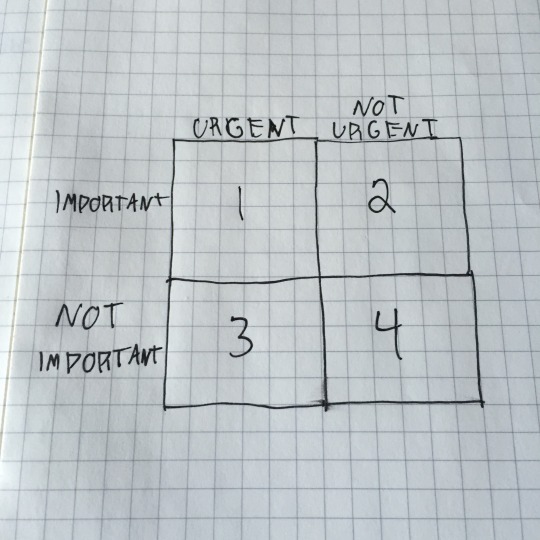on the ability to discern between urgency and importance
26 Jul 2016as the world becomes more notification-centric, the ability to discern between important, non-important, urgent, and non-urgent things is increasing. not only do individuals needs to be proficient at this, but as collaboration increases (because it’s the only way to solve some of the wicked problems we’ve got left or built for ourselves) it’s important for teams to proficient at this as well.
this post on mindtools has a really good explanation of the differences between each. it also has some tips about how to strategize in the long-term so that you get more important work done with less stress.

this post is about what happens when people fail to prioritize things properly. in my little sketch above, things are numbered in order of priority. to be honest, number 2 surprises most people, but i’ve found via my own experience that this is correct.
most places and organizations in which i’ve worked have problems with this prioritization. what happens is that everything that’s urgent is instantly classified as important and anything that’s not urgent is classified as not important. two classic examples are email and infrastructure.
email is almost always assumed to be important and urgent. this leads to people checking their email constantly. regardless of whether the new messages coming in are actually important or not, responses are sent quickly because the inbox is open all day in the case that something urgent and important does come in. however, this constant checking undermines focus, hinders higher-level brain function, and blocks flow.
in the long-run, this undermines an individual’s productivity. it also means they rarely get to the important but not urgent things, which typically slowly boil until they reach crisis mode. once in crisis mode, everything else must stop because now that issue/task has moved from important and not urgent to important and urgent.
the infrastructure issue happens all over america (education systems, roads, etc.), but in organizations this tends to look like social and technological infrastructure. tech is the one i see the most often. orgs will have obvious problems with their technology, but because people can still do their jobs, the work to the system is bypassed. it is classified non-urgent and non-important, which means it doesn’t get worked on. unfortunately, as the tech infrastructure problems build, people become increasingly frustrated and develop workarounds. soon enough, you have enough people with enough workarounds that even basic functions become difficult. you also often get to the point where people are frustrated enough with the poor infrastructure to abandon ship. it’s tragic to see poor infrastructure cause people to leave good organizations but it happens all the time. it happens in academia, government, non-profits, and more.
so the real trick is to figure out how to structure your (or your org’s) days and time so that you have time to work on the important but not urgent things as well as space to deal with urgent-important things (which are simply unavoidable because some crises are unpredictable) and urgent-not important things.
and not important-not urgent things? just say no.